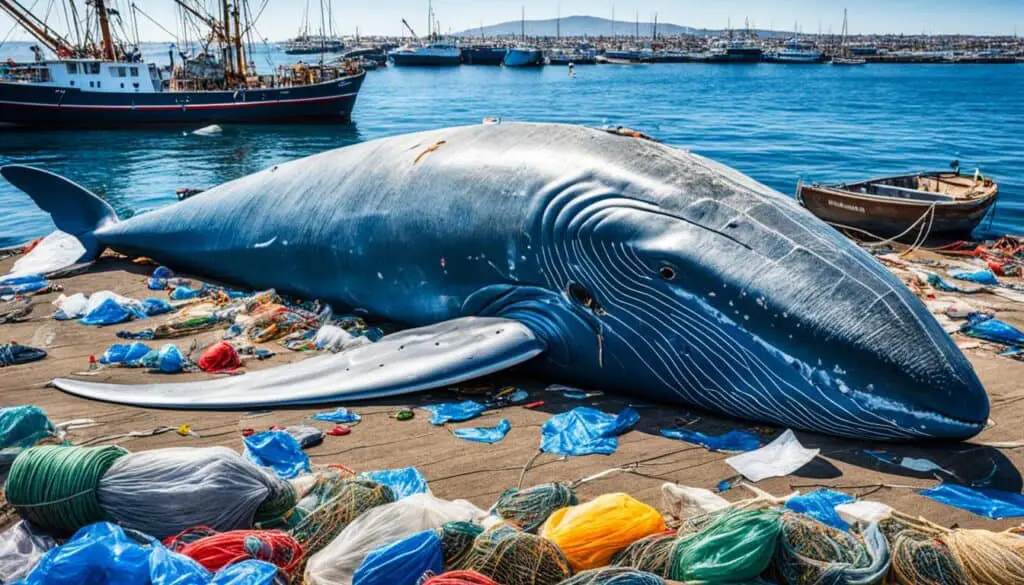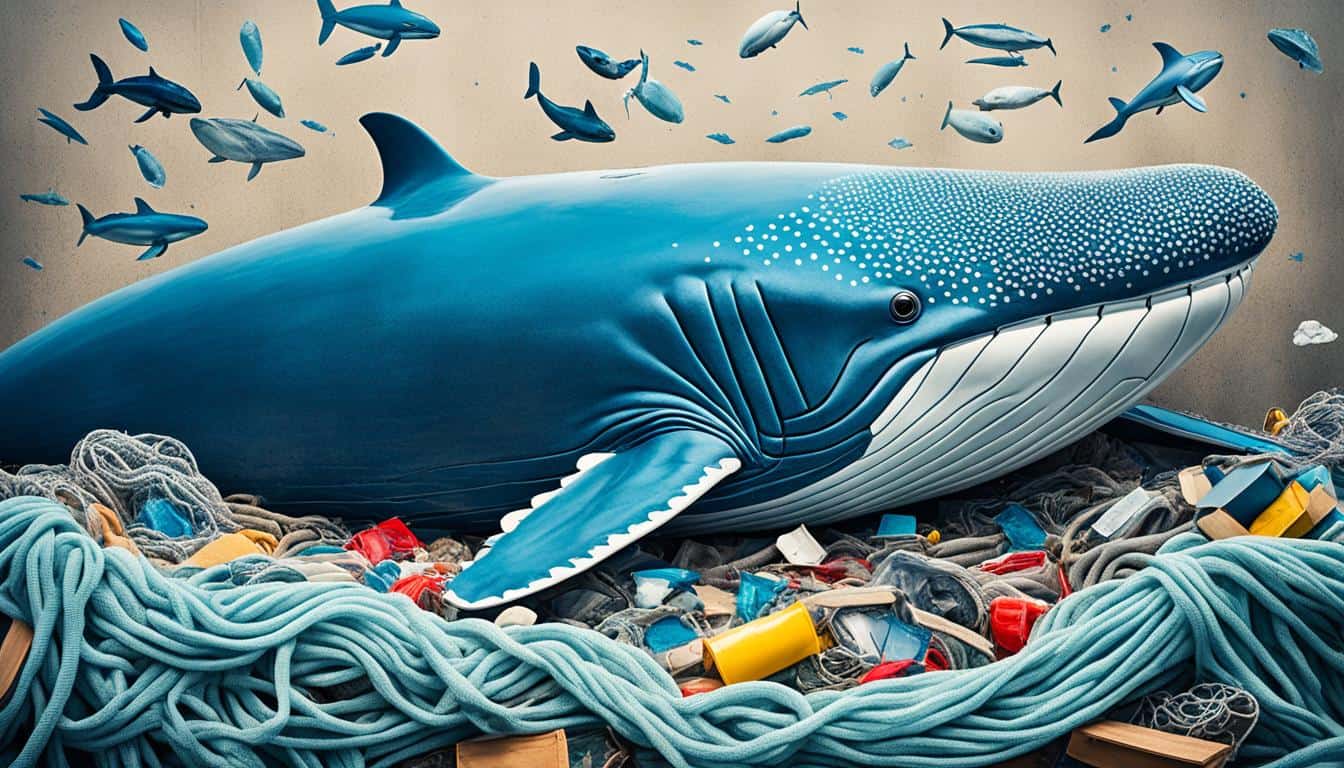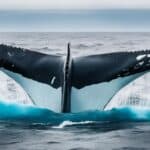Blue whales are the biggest animals on Earth, reaching over 30 meters long and weighing up to 330,000 lbs. They are as big as three school buses. But, there are only about 1,300 to 2,000 of them left. This makes them very vulnerable.
Knowing what threats blue whales face is key to saving them and keeping our oceans healthy. These threats include old whaling, ship strikes, getting caught in fishing gear, climate change, and ocean pollution.
By understanding these dangers, we can help protect these amazing creatures. This way, we can ensure they are safe for future generations.
Understanding Blue Whales and Their Importance
Blue whales are the biggest animals on Earth. They play a key role in the ocean’s health. It’s important to know the blue whales endangerment factors to protect them.
Size and Capacity
These whales, known as Balaenoptera musculus, can grow up to 70-110 feet long. They have a heart as big as a small car. They eat up to six tons of krill daily.
This eating helps control krill populations. It keeps the ocean’s balance.
Role in Marine Ecosystems
As top predators, blue whales keep marine food webs stable. Their eating habits affect krill and other sea creatures. They help with nutrient cycling and storing carbon in the ocean.
This makes them key in fighting climate change. We must tackle conservation challenges for blue whales to keep the ocean healthy.
| Aspect | Details |
|---|---|
| Length | 70-110 feet |
| Heart Size | Comparable to a small car |
| Daily Krill Consumption | Up to 6 tons |
| Role | Apex predator, ecosystem stabilizer |
| Conservation Challenges | Threats from climate change, pollution, and human activities |
What threats do blue whales face?
Blue whales face many dangers that affect their numbers. Human actions, like commercial whaling, have greatly reduced their population. Although whaling is banned, they still face many challenges today.
Habitat destruction is a big threat, as industrial activities harm their homes. Ships hitting blue whales is another major issue, causing injuries or death. Pollution also harms them, as toxic substances can contaminate their food, affecting their health.
Climate change makes things worse by changing the ocean and affecting krill, their main food. This makes it harder for blue whales to find enough to eat. This situation puts their survival at risk.
It’s important to understand these threats to help protect blue whales. Each threat adds to the danger, putting their future at risk. We need awareness and action to help these amazing sea creatures.
Historical Context of Blue Whale Endangerment
Understanding why blue whales are endangered is key to helping them. Over time, many factors have hurt their numbers, especially from human actions. Let’s explore how commercial whaling and current numbers show their plight.
Impact of Commercial Whaling
Commercial whaling started in the 16th century and hit blue whales hard. The Industrial Revolution made whale oil more valuable, leading to more hunting. By the 1960s, there were fewer blue whales than ever before.
International whaling bans came in the 1960s to save them, but it was too late. Laws protecting them in 1966 helped, but the damage was done. This led to a big drop in their numbers.
Current Population Estimates
Even with laws and conservation, blue whales are still in big trouble. Today, there are only about 1,300 to 2,000 left. Threats like ship strikes and harming their homes make it hard for them to recover.
So, these huge whales are still fighting to survive in a world that’s changing fast.
| Year | Population Estimate | Significant Events |
|---|---|---|
| 1900 | Up to 250,000 | Commercial whaling begins to rise. |
| 1966 | Approx. 10,000 | International whaling ban imposed. |
| 1970 | Officially endangered | Listed as endangered species. |
| 2023 | 1,300 – 2,000 | Ongoing conservation efforts in place. |
Major Human Activities Affecting Blue Whales
Blue whales face many threats from human actions. It’s crucial to understand these dangers to save them. Ship strikes and getting tangled in fishing gear are two big problems.
Ship Strikes
Blue whales often get hurt or killed by ships, especially in busy waters. Fast ships can hit these huge animals hard. These animals feed in areas where ships go, making accidents more likely.
Almost 80% of the world’s trade uses these shipping paths. These paths also cross where whales migrate.
Entanglement in Fishing Gear
Getting caught in fishing gear is another big threat to blue whales. They can get stuck in traps and nets. This can hurt their ability to feed.
Some whales stay trapped for a long time. They get tired and are more likely to die. This shows we need to keep working to protect blue whales from these dangers.

Environmental Threats to Blue Whales
Blue whales, the largest mammals on Earth, face many threats that affect their survival. These threats come from human actions and natural events, like climate change and pollution in the ocean. It’s important to know about these threats to help save this amazing species.
Climate Change Challenges
Climate change is changing ocean temperatures, which affects blue whales’ migration and food supply. Warmer waters can move the location of their main food, krill. This makes it harder for blue whales to survive in their homes.
Ocean Pollution
Ocean pollution is a big problem for blue whales. They can eat plastics and toxins, which can make them sick and affect their ability to have babies. Pollutants also build up in the food chain, making things worse for blue whales. We need to take action to protect these whales.
Conservation Challenges for Blue Whales
Understanding the challenges blue whales face can help protect these huge creatures. As the biggest animals on Earth, they are crucial for the ocean’s health. Yet, they face big threats that harm their numbers. Many conservation efforts are in place, but their complex habitats and human actions make it hard to protect them.
To help blue whales, we need to tackle threats from many angles. For example, changing ship routes and setting speed limits can lower the risk of ship strikes. Also, working with fishermen to make fishing gear safer can reduce entanglement risks.
Research and monitoring are key to saving blue whales. We need to learn more about their lives, where they go, and how many there are. This info helps us make better conservation plans. Working together with other countries and teaching people about blue whales can help fight threats like pollution and climate change. These are big hurdles for blue whale conservation.
FAQ
What threats do blue whales face?
Blue whales face threats from human activities like commercial whaling and ship strikes. They also face dangers from entanglement in fishing gear, climate change, and ocean pollution. These threats put their survival at risk.
Why are blue whales considered important in marine ecosystems?
Blue whales are key to marine ecosystems as apex predators. They help control krill populations and keep the ecosystem balanced. Their feeding also helps with nutrient cycling and fighting climate change.
How has commercial whaling impacted blue whale populations?
The commercial whaling industry, active from the 19th to the 20th century, greatly reduced blue whale numbers. This overhunting nearly made them extinct. Now, there are international bans on whaling to protect them.
What do current population estimates indicate about blue whales?
Today, there are only 1,300 to 2,000 blue whales left. Despite protection, their numbers are still critically low. Ongoing threats continue to put these magnificent creatures in danger.
What are the dangers of ship strikes to blue whales?
Fast-moving vessels often hit blue whales, killing or injuring them. This is a big risk, especially in busy shipping areas where whales feed.
How does fishing gear entanglement affect blue whales?
Getting tangled in fishing gear can badly hurt blue whales. It can also stop them from feeding. They may swim far with gear attached, risking death from exhaustion.
What challenges do climate change present to blue whales?
Climate change changes ocean temperatures and krill distribution, blue whales’ main food. This makes finding food harder for them.
How does ocean pollution threaten blue whales?
Ocean pollution is a big risk for blue whales. They can eat plastics and toxins, harming their health and ability to reproduce. Pollutants also affect their food, making things worse for their populations.
What conservation challenges do blue whales face today?
Blue whales face many challenges, like habitat damage, ship strikes, and gear entanglement. They need international cooperation to fight environmental degradation and climate change impacts.







